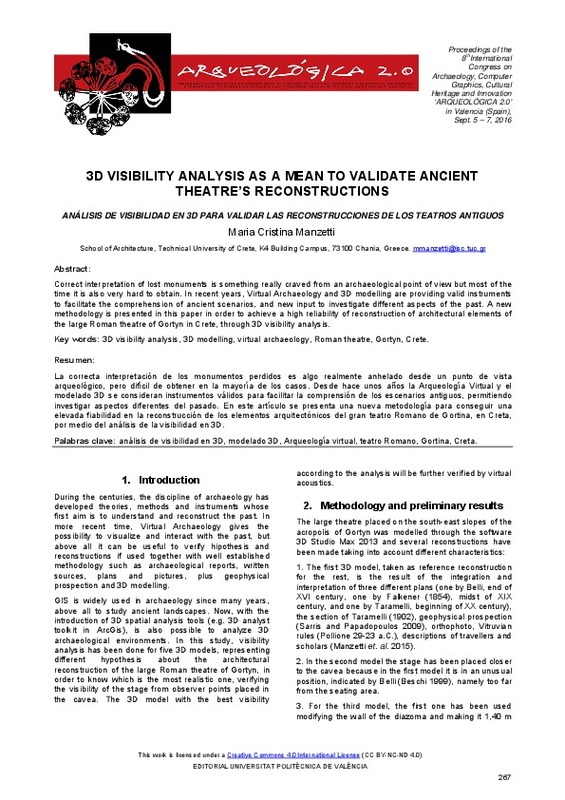JavaScript is disabled for your browser. Some features of this site may not work without it.
Buscar en RiuNet
Listar
Mi cuenta
Estadísticas
Ayuda RiuNet
Admin. UPV
3D VISIBILITY ANALYSIS AS A MEAN TO VALIDATE ANCIENT THEATRE’S RECONSTRUCTIONS
Mostrar el registro sencillo del ítem
Ficheros en el ítem
| dc.contributor.author | Manzetti, Maria Cristina
|
es_ES |
| dc.date.accessioned | 2017-07-21T07:13:58Z | |
| dc.date.available | 2017-07-21T07:13:58Z | |
| dc.date.issued | 2016-10-27 | |
| dc.identifier.isbn | 9788490484555 | |
| dc.identifier.uri | http://hdl.handle.net/10251/85567 | |
| dc.description.abstract | [EN] Correct interpretation of lost monuments is something really craved from an archaeological point of view but most of the time it is also very hard to obtain. In recent years, Virtual Archaeology and 3D modelling are providing valid instruments to facilitate the comprehension of ancient scenarios, and new input to investigate different aspects of the past. A new methodology is presented in this paper in order to achieve a high reliability of reconstruction of architectural elements of the large Roman theatre of Gortyn in Crete, through 3D visibility analysis. | es_ES |
| dc.description.abstract | [ES] La correcta interpretación de los monumentos perdidos es algo realmente anhelado desde un punto de vista arqueológico, pero difícil de obtener en la mayoría de los casos. Desde hace unos años la Arqueología Virtual y el modelado 3D se consideran instrumentos válidos para facilitar la comprensión de los escenarios antiguos, permitiendo investigar aspectos diferentes del pasado. En este artículo se presenta una nueva metodología para conseguir una elevada fiabilidad en la reconstrucción de los elementos arquitectónicos del gran teatro Romano de Gortina, en Creta, por medio del análisis de la visibilidad en 3D. | es_ES |
| dc.format.extent | 3 | es_ES |
| dc.language | Inglés | es_ES |
| dc.publisher | Editorial Universitat Politècnica de València | es_ES |
| dc.relation.ispartof | 8th International congress on archaeology, computer graphics, cultural heritage and innovation | es_ES |
| dc.rights | Reconocimiento - No comercial - Sin obra derivada (by-nc-nd) | es_ES |
| dc.subject | Data acquisition | es_ES |
| dc.subject | Photogrammetry | es_ES |
| dc.subject | Remote sensing | es_ES |
| dc.subject | Documentation | es_ES |
| dc.subject | Cultural heritage | es_ES |
| dc.subject | Digitisation | es_ES |
| dc.subject | 3D modelling | es_ES |
| dc.subject | Virtual archaeology | es_ES |
| dc.subject | Virtual museums | es_ES |
| dc.subject | Virtual exhibitions | es_ES |
| dc.subject | Gaming | es_ES |
| dc.subject | Collaborative environments | es_ES |
| dc.subject | Internet technology | es_ES |
| dc.subject | Social media | es_ES |
| dc.subject | Architecture | es_ES |
| dc.title | 3D VISIBILITY ANALYSIS AS A MEAN TO VALIDATE ANCIENT THEATRE’S RECONSTRUCTIONS | es_ES |
| dc.type | Capítulo de libro | es_ES |
| dc.type | Comunicación en congreso | es_ES |
| dc.identifier.doi | 10.4995/arqueologica8.2015.3060 | |
| dc.rights.accessRights | Abierto | es_ES |
| dc.description.bibliographicCitation | Manzetti, MC. (2016). 3D VISIBILITY ANALYSIS AS A MEAN TO VALIDATE ANCIENT THEATRE’S RECONSTRUCTIONS. En 8th International congress on archaeology, computer graphics, cultural heritage and innovation. Editorial Universitat Politècnica de València. 267-269. https://doi.org/10.4995/arqueologica8.2015.3060 | es_ES |
| dc.description.accrualMethod | OCS | es_ES |
| dc.relation.conferencename | ARQUEOLÓGICA 2.0 - 8th International Congress on Archaeology, Computer Graphics, Cultural Heritage and Innovation | es_ES |
| dc.relation.conferencedate | September 05-07,2016 | es_ES |
| dc.relation.conferenceplace | Valencia, Spain | es_ES |
| dc.relation.publisherversion | http://ocs.editorial.upv.es/index.php/arqueologica20/arqueologica8/paper/view/3060 | es_ES |
| dc.description.upvformatpinicio | 267 | es_ES |
| dc.description.upvformatpfin | 269 | es_ES |
| dc.type.version | info:eu-repo/semantics/publishedVersion | es_ES |
| dc.relation.pasarela | OCS\3060 | es_ES |








